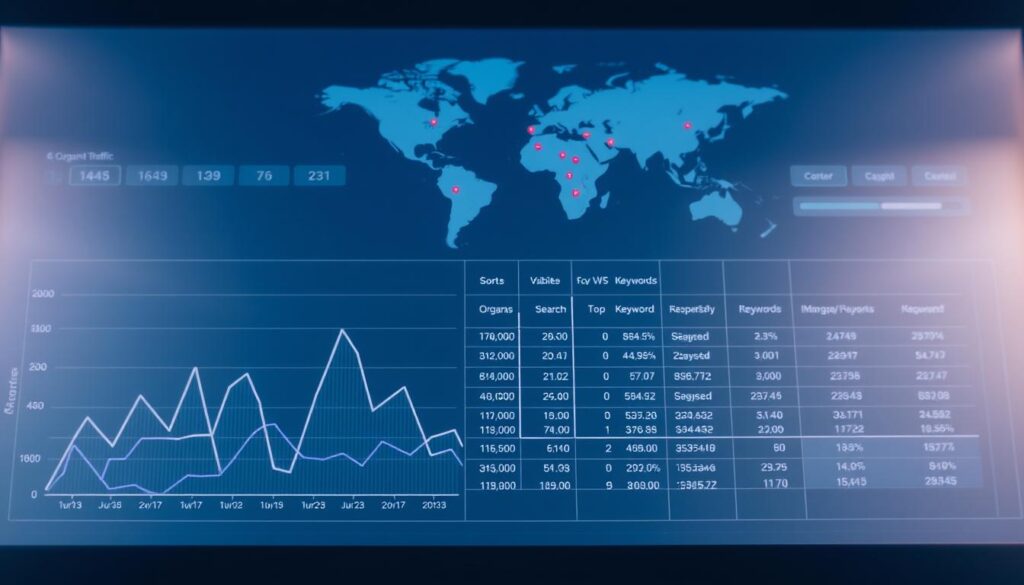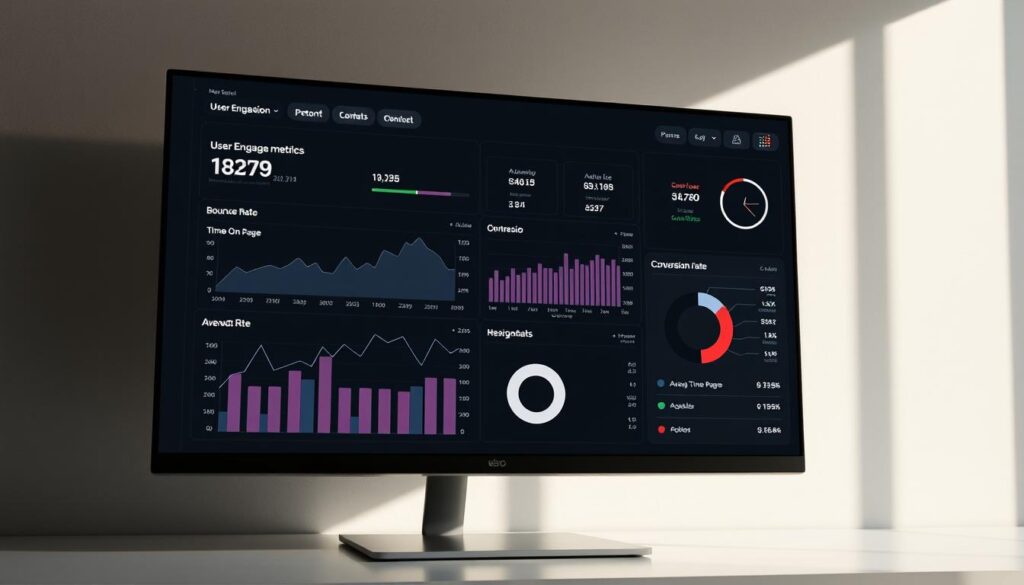Growing your online presence starts with understanding what truly moves the needle. While numbers can feel overwhelming, certain data points reveal how well your website performs in search engine results. These insights help you focus efforts where they’ll make the biggest impact.
Organic traffic remains the cornerstone of sustainable growth. This metric shows how many visitors find your site through unpaid Google search results. Tools like Google Search Console simplify tracking these trends, letting you spot opportunities to improve content or fix technical issues.
But numbers alone don’t tell the full story. A sudden drop in rankings might mean algorithm changes – not poor content. Similarly, high traffic with low conversions could indicate mismatched audience intent. Combining data from platforms like Ahrefs with context ensures smarter decisions.
This guide breaks down the metrics that deserve your attention. You’ll learn how to track progress, interpret fluctuations, and prioritize actions that align with business goals. Let’s simplify the complex world of search analytics together.
Key Takeaways
- Organic traffic reflects your website’s visibility in unpaid search results.
- Google Search Console provides actionable insights about technical health.
- Keyword rankings show how well your content matches user intent.
- Technical metrics like page speed directly impact user experience.
- Contextual analysis prevents misinterpretation of data trends.
Defining SEO Metrics and Their Business Impact
In the vast world of online marketing, certain data points act as your compass. They show where your website stands and where opportunities lie. Think of them as road signs guiding your strategy toward growth.
What Are SEO Metrics?
SEO metrics are measurable signals that reflect your site’s performance in search engines. Organic clicks, keyword rankings, and bounce rates all paint a picture of how well your content matches what users seek. Platforms like Google and Bing use these signals to decide which pages deserve top spots.
These numbers help businesses see what’s working and where improvements are needed. For example, a spike in traffic from specific keywords might reveal untapped audience interests. On the flip side, a high exit rate could signal confusing navigation.
Why Tracking Them Matters
Monitoring these trends lets you adapt quickly. If a competitor outranks you for a critical term, adjusting your content can reclaim visibility. Over time, consistent tracking builds a clearer path to higher conversions and customer trust.
Imagine running a store without checking sales data. You’d miss chances to stock popular items or fix layout issues. Similarly, ignoring search performance metrics means leaving growth opportunities on the table. In today’s crowded digital space, staying informed isn’t optional—it’s essential.
Analyzing Organic Traffic and Keyword Rankings
Understanding your website’s true potential starts with two pillars: who finds you and how they discover you. Non-paid visitors and strategic keyword alignment reveal gaps and opportunities in your digital strategy.
Organic Traffic Insights
Organic traffic acts like a popularity contest judges never announce. Google Analytics shows which pages attract visitors naturally. Look beyond the number of clicks – session duration and conversion rate indicate whether guests stay for coffee or leave immediately.

Ahrefs’ rank tracker helps spot patterns. A sudden 40% drop in blog visits? Check for outdated references or broken links. Steady growth in product pages? Double down on similar content.
Effective Keyword Ranking Strategies
Winning keywords requires understanding whispers before they become shouts. Tools like AnswerThePublic uncover questions people ask about your niche. For example:
- Target long-tail phrases like “best running shoes for flat feet” instead of generic terms
- Update old posts with fresh statistics and current examples
- Use location-based keywords if serving local audiences
One bakery boosted visibility by 65% after optimizing for “gluten-free birthday cakes near me”. They matched content to neighborhood searches while maintaining recipe quality. Track these shifts monthly to stay ahead of trends without drowning in data.
Which SEO Metrics Are Important to Track
Not all numbers deserve equal attention. While flashy charts might impress stakeholders, smart marketers focus on metrics that drive growth. Conversion rates and customer journey patterns often reveal more than raw traffic counts.
Focus on What Moves Revenue
Average session duration tells you if visitors actually read your content. One accounting firm discovered clients from pages where users spent 3+ minutes – now their primary focus. Compare that to social shares, which might boost ego but rarely predict sales.
Prioritize these three steps:
- Map keyword rankings to actual lead generation
- Set up goal tracking for newsletter signups or demo requests
- Compare monthly performance against customer acquisition costs
A local HVAC company doubled quote requests by ignoring “top 10” blog traffic and optimizing service page conversions instead. They tracked form submissions and phone calls – direct links to revenue.
“Measure what makes money, not what makes noise.”
Tools like Hotjar heatmaps help visualize user behavior. Pair this with Google Analytics’ conversion paths to see which results justify your time. Remember: sustainable growth comes from understanding value, not vanity.
Assessing Technical SEO and Site Health
Think of your website as a car – even the flashiest paint job won’t matter if the engine sputters. Technical health ensures your pages run smoothly for both users and search engines. Let’s explore what keeps your digital vehicle highway-ready.
Core Web Vitals Explained
Google measures site speed and responsiveness through three key metrics:
| Metric | Ideal Threshold | User Impact |
|---|---|---|
| Largest Contentful Paint | How fast main content loads | |
| First Input Delay | Responsiveness to clicks/taps | |
| Cumulative Layout Shift | Visual stability during loading |
Slow pages frustrate visitors and hurt rankings. A travel blog reduced bounce rates by 22% after fixing layout shifts caused by oversized images.
Index Coverage and Health Score
Google Search Console shows which pages get indexed. Common red flags include:
- 404 errors from deleted product listings
- Duplicate content confusing search engines
- Blocked resources preventing proper crawling
One e-commerce site recovered 3,000 missing product pages by fixing robots.txt errors. Regular checks prevent valuable content from vanishing from engine results.
Resolving Technical Issues
Start with these steps every quarter:
- Run Ahrefs’ Site Audit for crawl error reports
- Compress images above 100KB
- Fix mixed content warnings (HTTP/HTTPS conflicts)
Remember: A technically sound domain creates better experiences for human users and algorithmic crawlers alike. Proactive maintenance saves future efforts while keeping your site visible.
Measuring User Engagement and Behavior
Your audience’s actions tell a story search engines can’t ignore. How people interact with your pages reveals whether your content truly answers their questions – or sends them scrambling for better options.

Bounce Rate and Exit Rate Considerations
A high bounce rate percentage doesn’t always spell disaster. If someone finds your recipe blog’s blueberry muffin instructions in 10 seconds and leaves satisfied, that’s a win. But if 80% abandon your pricing page immediately, your message might clash with visitor expectations.
Exit rates can trick you too. A 70% exit rate on a “Thank You” page after purchases makes sense. The same percentage on a product comparison guide suggests missing information. Google Analytics’ Behavior Flow report helps spot these patterns.
Session Duration and Dwell Time
Pages where users spend 3+ minutes often become ranking superstars. One cooking site noticed posts with video tutorials kept visitors 40% longer than text-only versions. Search engines interpret this as quality signals.
Try these ways to boost engagement:
- Break long articles into scannable sections with bold subheadings
- Add relevant images or infographics every 300 words
- Include quick polls or calculators for interactive elements
Small web layout tweaks can work magic. A financial advisor increased average session duration by 22% simply by moving key contact forms above the fold. Remember: happy users lead to happier ranking algorithms.
Evaluating Competitor Performance and Backlink Quality
Your competitors’ strategies hold clues to your next big win. By analyzing their backlink profiles and traffic patterns, you uncover gaps in your own approach while spotting untapped opportunities. Tools like Ahrefs and SEMrush turn this reconnaissance into actionable insights.
Referring Domains Analysis
High-quality links from diverse websites act like votes of confidence. Sites with 50+ referring domains often rank higher than those relying on spammy directories. Focus on earning links from industry blogs or local news outlets rather than irrelevant forums.
Organic Traffic Competitor Comparison
SEMrush’s Traffic Analytics reveals which pages drive visitors to rival sites. Compare your top-performing content with theirs. Are they ranking for keywords you’ve overlooked? A coffee shop discovered competitors gained traction with “cold brew delivery” guides – then created a superior version.
Traffic Value and Cost Metrics
Estimate organic traffic value by comparing it to paid ads. If a competitor gets 5,000 monthly visits for “vegan meal prep,” and the average CPC is $2.50, that’s $12,500 in potential ad savings. Use this data to justify content upgrades.
| Competitor | Traffic Volume | Estimated CPC | Monthly Value |
|---|---|---|---|
| Brand A | 8,200 | $1.80 | $14,760 |
| Brand B | 6,500 | $2.10 | $13,650 |
| Your Site | 4,300 | $1.95 | $8,385 |
One boutique doubled its traffic value in six months by refining blog posts targeting low-competition keywords. Regular check-ins with Google Analytics benchmarks keep efforts aligned with market shifts.
Utilizing SEO Tools for Enhanced Performance
The right tools transform guesswork into actionable plans. Whether you’re refining content or fixing site errors, these platforms provide clarity in a crowded digital landscape.
Google Search Console and Analytics
Google Search Console acts as your website’s annual checkup. It flags crawl errors, highlights top-performing pages, and reveals mobile usability issues. Pair it with Google Analytics to connect rankings with real-world actions – like how a blog post’s traffic converts into newsletter signups.
Three ways to maximize these free tools:
- Set up custom alerts for sudden ranking drops
- Filter data by device type to optimize mobile experiences
- Track “not found” errors before they hurt visibility
Third-Party Tools for SERP Visibility
Platforms like Ahrefs and SEMrush dig deeper than surface-level stats. Their keyword gap analysis shows where competitors rank that you don’t. One eco-store uncovered 120 low-competition product keywords this way, boosting sales by 18% in three months.
Regular audits prevent small issues from becoming crises. For example:
- Use Screaming Frog to spot broken internal links
- Check Moz’s Domain Authority before pursuing backlinks
- Analyze heatmaps to reduce bounce rates on key pages
Mastering these platforms takes time, but the payoff is worth it. Start with one tool this week – your future self will thank you.
Conclusion
Effective online growth stems from prioritizing data that drives decisions. Focus on organic traffic patterns, technical health checks, and user behavior trends to build sustainable visibility. These elements work together like gears in a clock – each turning the others toward better search engine performance.
Regular audits using tools like Google Analytics or SEMrush help spot hidden opportunities. Track pages that convert visitors into customers, not just those with flashy traffic numbers. Remember: a fast-loading page with mediocre content often outperforms slow, polished ones.
Ready to see real results? Start by reviewing your top three landing pages this week. Compare their engagement rates against competitor benchmarks. Small tweaks to meta descriptions or internal links can create ripple effects across your business growth.
Keep learning as algorithms evolve. Subscribe to industry newsletters or join webmaster forums for fresh tactics. Every improvement you make today strengthens your digital foundation for tomorrow’s challenges.
Your next step: Block 30 minutes to analyze one critical metric you’ve ignored. Adjust your marketing strategy based on what the numbers reveal – not guesses. Business owners who master this habit consistently outpace rivals in search rankings.
